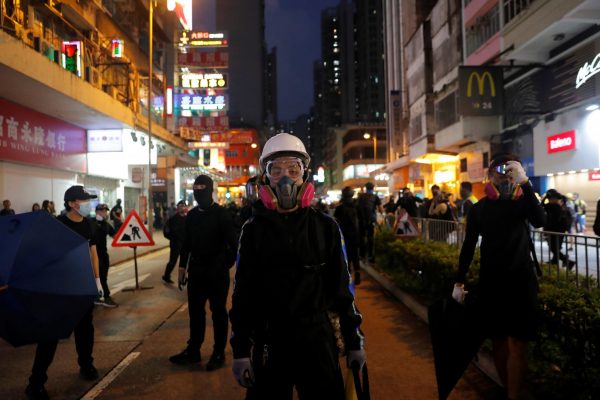The street protests began in June in response to an extradition bill proposed by Hong Kong’s executive. Under the terms of the bill, Beijing could request the extradition of Hong Kong residents accused of a crime in the People’s Republic of China. The extradition bill was widely seen as an attack on Hong Kong’s autonomy and freedom because it would enable China’s authoritarian government to get their hands not only on wanted felons, but theoretically on anyone who displeased it, including dissidents. It was also seen as confirmation that Hong Kong’s government cared more about its political masters in Beijing than the citizens of Hong Kong.
With Beijing’s backing, Hong Kong Chief Executive Carrie Lam at first stood firm, but eventually relented as protests swelled to hundreds of thousands of people and it became clear that opposition to the bill was widespread and deeply felt. Ms Lam agreed to shelve the bill. But the protest movement raged on, demanding that the bill be completely withdrawn, and that an independent inquiry be held into police responses to the protests. In July protesters stormed parliament. Ms Lam ultimately agreed to withdraw the extradition bill, but the gesture appeared to come too late to quell the protests, which soon gave voice to other grievances and demands.
As Tim Summers notes in one of two lead articles this week, Hong Kong’s protest movement ‘has ventured far beyond the original catalyst, the government’s extradition bill,’ to reflect ‘deep dislocations in Hong Kong’ including ‘identity politics and socio-economic problems’ that have been simmering since the territory’s return to Chinese sovereignty two decades ago. Summers notes protesters’ demands for universal suffrage and political reform (Hong Kong’s convoluted electoral system ensures that only Beijing-backed candidates can be selected as chief executive), but is sceptical about the prospects for such reform given that Beijing’s approval would be needed. Summers argues that politicians should instead turn their attention to ‘daily gripes’ about education, healthcare, public transport and housing affordability.
In her annual policy address to the Legislative Council (LegCo) on 16 October, Ms Lam attempted to do just that. In the address, which is similar to the State of the Union address delivered annually by the US President to Congress, Ms Lam sought to focus on economic grievances, proposing to reclaim more land and to build more public housing. But Ms Lam was heckled by councillors before she got to the podium. Someone played a recording of protestors’ screams as they were hit with tear gas by police. Outside, protesters gathered to demand her resignation. The reception was so hostile that, after two failed attempts to speak directly to councillors, Ms Lam was forced to retreat to a secure location to give her address via video.
Before it was delivered, the address was widely seen as a critical test for Ms Lam and her ability to manage the upswell of discontent. What happens next is unclear. More concessions are unlikely. The police have been given new powers and, since 4 October, protestors are prohibited from wearing masks which, along with umbrellas, had become a potent symbol of the protest movement.
In our other lead article this week, Ben Hillman writes that public opinion on the Chinese Mainland is strongly in favour of direct intervention in Hong Kong — something Beijing has threatened if Hong Kong’s political and business elite are unable to find a solution to the protests which are now in their 20th week. Hillman says that China’s state-run media have portrayed the protests as a pro-Hong Kong independence movement led by ‘criminals and terrorists’ and supported by ‘foreign black hands’. Hillman says that one-sided media coverage has left the mainstream Chinese public unaware of Hong Kongers’ grievances, including the extradition bill.
Mainlanders have become incensed at protestors’ apparent disloyalty. Hillman argues that the Chinese Communist Party’s (CCP) depiction of the protests is dangerous and risks painting Chinese President Xi Jinping into a corner. As protestors have begun calling for greater foreign pressure on Beijing (On 15 October the US Congress passed the Hong Kong Human Rights and Democracy Act in support of the protests), there is mounting pressure on Xi to take action or risk being perceived as weak and ineffectual at a time when questions are being raised about his judgment on other matters such as trade negotiations with the United States.
But if Xi sends in the People’s Liberation Army, which is his only obvious tool for squashing the protest movement, he will, in one fell swoop, bring an end to the ‘one country, two systems’ model. As Hillman argues, this would be a huge setback for Xi’s aspiration for Taiwan’s reunification that the CCP proposes to achieve via the same ‘one country, two systems’ model. Forceful intervention in Hong Kong would also greatly undermine Hong Kong’s wider value to China as a liberal hub of international commerce — a place where international corporations routinely enter into contracts with Chinese businesses precisely because of their confidence in Hong Kong’s rule of law and independent judiciary.
It is essential that Hong Kong’s leaders find ways to balance Beijing’s demands with the expectations of Hong Kong’s citizens and be able to communicate those strategies effectively to the Hong Kong people. That will most likely require further concessions to protestors’ demands, including amnesty for those arrested and an inquiry into police use of force. Trust between the people and government of Hong Kong has reached such a low point that new leadership is probably needed to break the impasse. Conceding to protestors’ demands for Ms Lam’s resignation will carry risks for Beijing, where leaders fret that concessions will only lead to more demands, but it is a risk worth taking. The alternatives are likely to be much worse.
The EAF Editorial Board is located in the Crawford School of Public Policy, College of Asia and the Pacific, The Australian National University.

